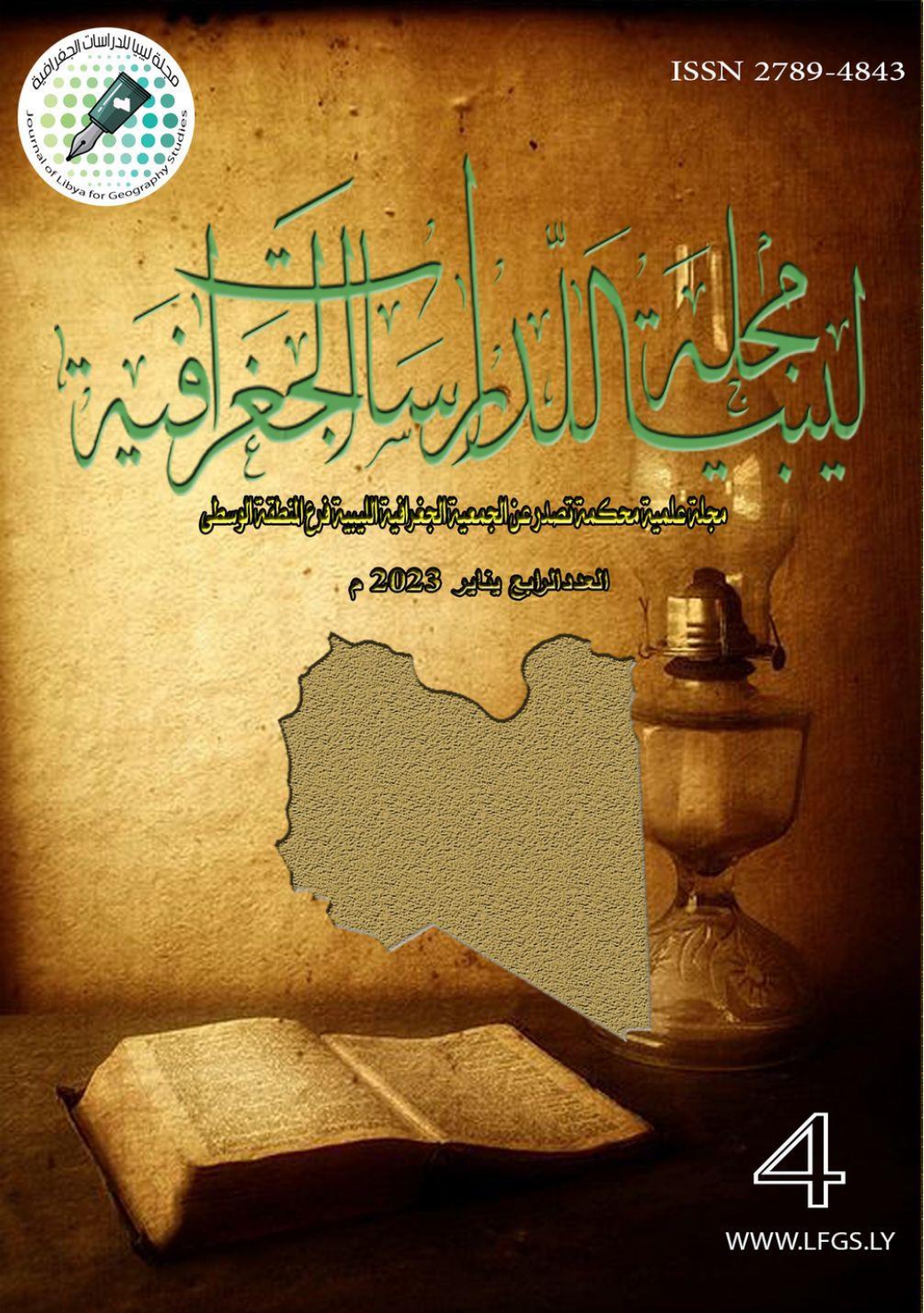Application of Dust Index (NDDI) to determine the sensitivity of soil to wind erosion in Taiz Governorate
DOI:
https://doi.org/10.37375/jlgs.vi4.1760Keywords:
Dust storms, wind, erosion, Remote sensing, Taiz GovernorateAbstract
The research aims to verify extent of soil sensitivity to wind erosion in governorate of Taiz, and identify areas most affected by soil wind erosion in governorate during dry season between (October - May) 2018.
The research methodology was represented by using dust index, to derive information layers that show soil sensitivity to wind erosion in dry season, from remote sensing data, represented by satellite image of MODIS Terra, obtained from the NASA website. and applied this index to bands of satellite image that used in determining areas of dust spread, or areas where its soil suffer of sensitive highly of erosion to monthly level.
Results of research found that locations of regions affected by risk of wind erosion different from month to month, and therefore area of zone that was exposed to wind erosion during dry season reached 4441.7 km2, percent 44.3% of total area of governorate. and area of most affected by wind erosion reached 771.4 km2, percent 7.7% of total area of governorate.
The research concluded that spatial variation of soil sensitivity to wind erosion in governorate, It is due to properties of soil, and change in cohesion strength of its grains from one month to another, due to practice of plowing, soil moisture, and extent cover vegetation and agriculture. with other climate variables particular, variation in wind speed, and precipitation rates, temperature, dryness severity, and humidity level.
References
المراجع العربية:
- الدوسري. علي. (2018). ظاهرة الغبار محليًا وإقليميًا وعالميًا، معهد الكويت للأبحاث العلمية، مركز أبحاث البيئة والعلوم الحياتية.
- راشد. عماد. (2011). دراسة تأثير بعض العناصر الجوية على العواصف الغبارية لمناطق مختارة من العراق، مجلة علوم المستنصرية، المجلد، 22، العدد، 4.
- غريب. إسماعيل. (1983). العواصف الترابية وآثارها على البيئة في الكويت، سلسلة نشرات ثقافية تعني بقضايا البيئة تصدرها جمعية حماية البيئة، العدد، 9 .
- كاظم. محمد. (2012). رصد العواصف الغبارية باستخدام الأقمار الصناعية الأنوائية: (2012). وقائع المؤتمر الأول للعواصف الغبارية وتأثيراتها البيئية - الأسباب والمعالجات.
المراجع الأجنبية:
- Behbahani.A. (2015). Hazard and Risk Assessment of Wind Erosion and Dust Emissions in Denmark - A Simulation and Modeling Approach, Doctoral Thesis, University of Basel, Faculty of Science, pp.1-132.
- Borrelli, p., Lugato, E., Montanarella, L., Panagos, P. (2017). A New Assessment of Soil Loss Due to Wind Erosion in European Agricultural Soils Using a Quantitative Spatially Distributed Modeling Approach, land degradation & development Land Degrade. Develop, Voll, 28,pp. 335–344.
- Chavez, S., Mackinnon, D. J., Reynolds, R. L., Velasco, M.G.(2002). Monitoring dust storms and mapping landscape vulnerability to wind erosion using satellite and ground-based digital images, Arid Lands, No, 51.pp.1-8.
- Cho, H.M., Nasiri, S.L., Yang, p. (2013). Detection of Optically Thin Mineral Dust Aerosol Layers over the Ocean Using MODIS, Journal of atmospheric and oceanic technology,Voll, 30, pp. 896-916.
- Ciren, P., Kondragunta, S. (2014). Dust aerosol index (DAI) algorithm for MODIS, Journal of Geophysical Research Atmospheres, Vol, 119 pp. 4470- 4792.
- Guo,B., Zhang, F., Yang, G., Sun. F., Jiang. L.(2017). Improved estimation method of soil wind erosion based on remote sensing and geographic information system in the Xinjiang Uygur Autonomous Region, China, Geomatics natural hazards and risk,Voll, 8, No, 2, pp. 1752 –1767.
- Haghighi. S., Akhzari. D., Attaeian, B., Gonbad, B. (2018). The effect of drought in the source area of dust storms on vegetation change (case study: western parts of Iran), Environmental Resources Research, Vol, 6, No, 2, pp.195-200.
- Heidarian, P., Azhdari, A., Joudaki, M., Khatooni, J., Dufiroozjaei, S. (2018). Integrating Remote Sensing, GIS, and Sedimentology Techniques for Identifying Dust Storm Sources: A Case Study in Khuzestan, Iran, Journal of the Indian Society of Remote Sensing, Voll, 2, pp. 1-15.
- Holdt, J. R., Eckardt, F. D., Wiggs. G. F. S.(2017). Landsat identifies Aeolian dust emission dynamics at the landform scale, Remote Sensing of Environment, Vol, 198, pp. 229 –243.
- https://search.earthdata.nasa.gov/search/granules?polygon.
- Katra, I. (2020). Soil Erosion by Wind and Dust Emission in Semi-Arid Soils Due to Agricultural Activities, Agronomy, Vol, 10, Issu, 89, -pp.2-10.
- Laura, A., Oro, D., Daniel, E., Buschiazzo, E. (2009). Threshold wind velocity as an index of soil susceptibility to wind erosion under variable climatic conditions, land degradation & development, Vol, 20, pp.14-21.
- Mezosi, G., Blanka, V., Bata, T., Kovacs, F., Meyer, B. (2012). Estimation of regional differences in wind erosion sensitivity in Hungary, Nat. Hazards Earth Syst. Sci, Vol, 15, pp. 97–107.
- Prachi, M., pravin, K. (2014). detection and monitoring of two dust storm events by multispectral MODIS images, Journal of Environmental Research And Development, Vol, 8, No, 04, pp. 974-982.
- Qu, J.J., & Kafatos, M. (2006). Asian dust storm monitoring combining Terra and Aqua MODIS SRB measurements. Geosciences and Remote Sensing letters, Vol, 3 (4), pp. 484 - 486.
- Raissouni, A., Issa, L. K. E.A., Maâtouk, M., Passalacqua, R. (2012). GIS - Based Model to Assess Erosion Sensitivity in Northern Morocco. Laou Watershed Case Study, International Journal of Geosciences, Voll, 3, pp. 610-626.
- Rezaei, M., Sameni, A., Shamsi, S., Bartholomeus, H. (2016). Remote sensing of land use/cover changes and its effect on wind erosion potential in southern Iran, Peer, 4, pp. 1-24.
- Reynold, R., Yount, J., Reheis, M., Goldstein, H. (2007). Dust Emission from Wet and Dry Playas in the Mojave Desert, USA, Earth Surface Processes and Landforms, Voll, 32, pp.1811-1827.
- Saadoud, S., Hassani, M., Peinado. F., Guettouche, M. (2018). Application of fuzzy logic approach for wind erosion hazard mapping in Laghouat region (Algeria) using remote sensing and GIS, Aeolian Research, Vol, 32, pp. 24-34.
- Samadi, S., Boloorani. A., Alavipanah, S . K., Mohamadi, H., Najafi, M.S. (2014). Global dust Detection Index (GDDI); a new remotely sensed methodology for dust storms detection, Journal of Environmental Health Science & Engineering, Voll, 12, pp. 12-20.
- Setianto, A., Triandini, T. (2013). Comparison of Kriging and Inverse Distance Weighted (IDW) Interpolation Methods in Lineament Extraction and Analysis, J. SE Asian Appl. Geol, Vol, 5(1), pp. 21–29.
- Shahrisvand, M., Akhoondzadeh, M. (2014). A comparison of empirical and intelligent methods for dust detection using MODIS satellite data, International Archives of the Photogrammetry, Remote Sensing and Spatial Information Sciences, Vol, XL-1/W3, pp. 371-375.
- Shi, P., Yan, P. (2004). Wind erosion research in China past, present and future, Progress in Physical Geography, Voll, 28, pp. 366–386.
- Sinclair, S. N., Jones, S . L. (2017). Subjective Mapping of Dust-Emission Sources by Using MODIS Imagery, U.S. Army Engineer Research and Development Center (ERDC), Cold Regions Research and Engineering Laboratory (CRREL), 72 Lyme Road, Hanover, NH 03755-1290.
- Taghavi, F., Owlad, E., Ackerman. S. A. (2017). Enhancement and identification of dust events in the south-west region of Iran using satellite observations, J. Earth Syst. Sci, Voll, 126, pp.1-28.
- Taramelli, M., Pasqui. M., Kirschbaum . D., Bottai, L., Busillo. B., Calastrini, F., Guarnieri, F., Small. C. (2012). Spatial and temporal dust source variability in northern China identified using advanced remote sensing analysis, Earth Surf Process Landforms, Published online in Wiley Online Library, pp.1-17.
- Yue, Y., Shi, P., Zou, X., Ye, X., Zhu, A., Wang, J .(2015). The measurement of wind erosion through field survey and remote sensing: a case study of the Mu Us Desert, China, Natural Hazards volume 76, pp.1497–1514.
- Webb, N. P., Zee, J. W. V., Karl, J., W., et al. (2017). Enhancing Wind Erosion Monitoring and Assessment for U.S. Rangelands, Vol, 39, Issu, 3–4, pp. 85-96.














